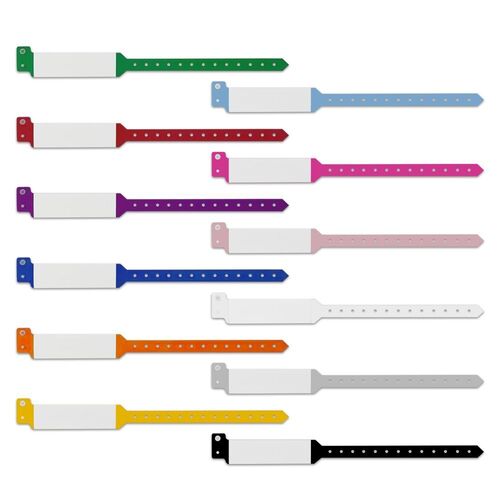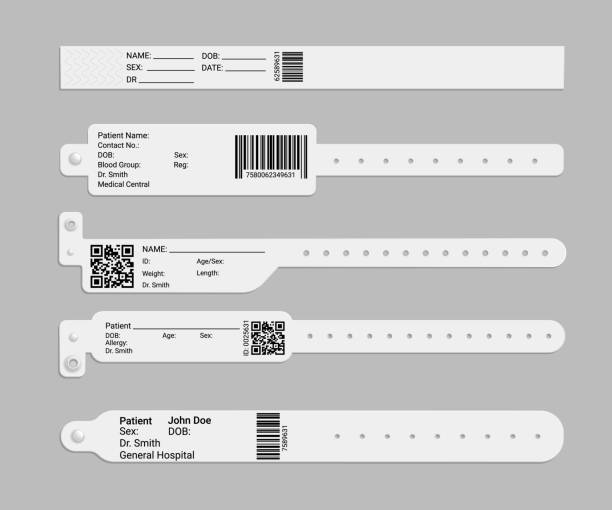How to Ensure the Security and Correctness of Patient Information with a Patient Identification Band
How to Ensure the Security and Correctness of Patient Information with a Patient Identification Band
Blog Article
Exploring the Numerous Kinds of Patient Identification Band Used in Medical Facilities
In the intricate globe of medical care, the important duty of Patient Identification bands typically goes undetected. These bands, varying from basic paper wristbands to sophisticated RFID bands, create the backbone of Patient safety and security methods, making certain accuracy in Patient Identification. The large variety of these bands, each with its distinct benefits and constraints, is usually overlooked. As we navigate through this topic, one may acquire insight into the refined complexities and important importance of such bands in clinical centers.
Understanding the Significance of Patient Identification Bands
While they may seem like plain accessories, Patient Identification bands play a vital duty in clinical facilities. These bands act as a crucial tool for validating Patient identity, stopping medical mistakes connected to misidentification. The bands commonly display important info such as the Patient's name, age, blood type, and any kind of well-known allergic reactions. They allow medical care experts to swiftly access this crucial info, thereby promoting timely and precise clinical treatment. Patient Identification bands also aid in streamlining management tasks, guaranteeing exact record-keeping and payment. In spite of their simpleness, these bands symbolize the concept of Patient safety, a keystone of top quality wellness care. Without them, the risk of clinical mistakes, and subsequently, Patient damage, could significantly enhance.
Standard Paper Wristbands: Their Use and Limitations
Standard paper wristbands have actually been a staple in Patient Identification throughout different clinical facilities. While their usage prevails, they nurture particular restrictions that might influence their performance in Patient management. This section will concentrate on the scope of their application and the fundamental disadvantages connected with their usage.
Paper Wristbands: Use Scope
In the world of Patient Identification, paper wristbands have long held a critical function. These bands are normally utilized in outpatient settings, where the Patient's stay is short-term. The wristbands contain vital info such as the Patient's name, day of birth, and a special Identification number. This easy, yet reliable system, allows doctor to quickly and properly identify patients, making sure the proper therapy is provided. Paper wristbands are also used in emergency situation situations, where fast Identification is paramount. Their use encompasses events like blood donation drives and mass inoculation programs, further emphasizing their flexibility. Regardless of advancements in modern technology, the modest paper wristband remains a dependable and cost-efficient option for Patient Identification in various medical care scenarios.
Limitations of Paper Wristbands
Despite their extensive use, paper wristbands are not without their downsides. Their physical longevity is just one of the substantial constraints. Direct exposure to water, sweat, or misuse can provide them unreadable or even create them to degenerate. On top of that, paper wristbands typically lack the technical abilities of more modern-day alternatives, such as barcoding or RFID chips, limiting their capability to simply displaying created details. The inability to update or customize the information on the wristband is another drawback. In addition, if the details is handwritten, clarity can be jeopardized, causing possible misidentification. Lastly, paper wristbands can cause discomfort or skin irritability to some people, specifically when put on for prolonged periods.
Barcoded Wristbands: Innovations in Patient Identification
While Patient Identification has actually long been a crucial aspect of health care, the introduction of barcoded wristbands indicates a considerable jump ahead. These bands take advantage of the simplicity of barcoding innovation, enabling for Patient details to be promptly scanned and accessed. They enhance the speed and accuracy of Patient Identification, minimizing the risk of medical errors connected to misidentification.
Superhigh Frequency Identification (RFID) Bands: an Action Towards Futuristic Healthcare
The evolution of Patient Identification bands has brought about the development of Radio Frequency Identification (RFID) Bands (patient identification band). These cutting-edge gadgets present crucial advantages for health care centers, supplying a much more efficient and technically advanced methods of Patient Identification. The application of RFID in healthcare is a significant step towards a much more futuristic strategy to Patient administration and safety
Understanding RFID Bands

RFID Bands: Secret Advantages
Accepting a future where modern technology and medical care combine, superhigh frequency Identification bands supply numerous key benefits. Largely, these bands enhance Patient safety by giving exact, immediate Identification, thus reducing clinical mistakes. RFID bands can store a vast quantity of Patient information, including clinical background and allergies, making it possible for individualized treatment. They additionally enhance administrative jobs, as the automated data entry changes manual procedures, enhancing efficiency and lowering documents. RFID bands supply real-time monitoring Read Full Article of individuals, vital in risky atmospheres such as surgical procedure or intensive treatment. These bands are resilient and resistant to ecological aspects, ensuring constant functionality. Generally, RFID bands represent a considerable advancement in Patient Identification innovation, benefiting both patients and medical care providers.
Executing RFID in Healthcare
These bands offer a smooth method to track and recognize clients, ensuring their safety and enhancing efficiency in therapy procedures. RFID bands reduce clinical mistakes by offering exact Patient Identification, which is essential in protecting against misdiagnosis or wrong medicine management. Therefore, the execution of RFID bands is a substantial action in the direction of enhancing Patient safety and health care distribution.

Color-Coded Wristbands: Assisting in Quick and Accurate Diagnosis
In the dynamic atmosphere of a medical center, color-coded wristbands have arised as essential tools for swift and specific Identification of an individual's medical problem. These wristbands, put on by individuals, lug details colors that correspond to various medical conditions or statuses. Red could show allergy risks, while yellow could symbolize a fall threat. This system is created to provide prompt visual cues to doctor, improving Patient safety and care high quality. In emergency situation circumstances, using these wristbands permits for rapid decision-making. The effectiveness of color-coded wristbands depends on the uniformity of shade interpretation across medical care organizations, calling for typical requirements for regular application.
Methods for Reliable Execution and Management of Patient ID Bands
Accomplishing optimum use of Patient Identification bands demands a well-structured method for their application and monitoring. Patient education is additionally crucial; patients have to recognize the purpose of the bands and the requirement for their constant wear. It's crucial to have a backup strategy in location, such as barcode scanning or biometrics, to make certain that Patient Identification is never jeopardized.
Verdict
Patient Identification bands are vital in clinical facilities to make certain safety and precision. Standard paper, barcoded, RFID, and color-coded wristbands each hold unique benefits, varying from cost-effectiveness to advanced information storage space and immediate clinical alerts. Efficient application and management of these bands can substantially lower medical mistakes, improve effectiveness, and boost overall Patient treatment. Hence, understanding and utilizing these Identification tools is extremely important for keeping high standards in healthcare.
These bands, varying from straightforward paper wristbands to sophisticated RFID bands, create the foundation of Patient safety and security methods, guaranteeing precision in Patient Identification.The development of Patient Identification bands has actually brought about the development of Radio Frequency Identification (RFID) Bands. In general, RFID bands represent a significant development in Patient Identification technology, benefiting both clients and health care carriers.
RFID bands lower clinical mistakes by supplying precise Patient Identification, which is crucial in preventing misdiagnosis or incorrect medicine management. Patient education is also crucial; people need to understand the function of the bands and the requirement for their constant wear.
Report this page